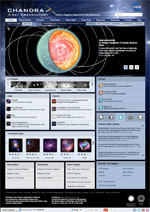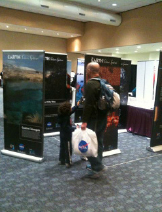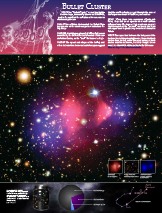
| Our goals are to open access for anyone to be a learner and explorer of the Universe, to share new discoveries about the Universe with a wide variety of audiences, engage the imaginations of students, teachers, and the greater public, and increase learning opportunities. | |||
|
The Chandra Communications and Public Engagement (CPE) group is responsible for connecting Chandra and its science to the broadest possible audiences. Chandra provides a multifaceted CPE program encompassing press communications, public engagement and informal learning that reaches a large audience of national and international scope. Chandra's program plays a key role in increasing science literacy and contributing to science, mathematics, engineering and technology (STEM) education by synthesizing and disseminating results from NASA's exploration of the high-energy Universe.
The Chandra CPE group works through a multi-layered, multi-pronged approach. Beginning with peer-reviewed science results and press and image releases, Chandra science flows through a variety of innovative projects and platforms. The results have been demonstrably successful and some recent highlights are outlined below.
Chandra CPE has consistently documented best practices and outcomes of Chandra's Communications & Public Engagement program and its activities and projects in numerous journal articles in peer-reviewed publications such as the journals Science Communication, and Communicating Astronomy with the Public. Chandra CPE has also received recognition for its projects and digital content through international communication awards, over a dozen US digital awards as well as internal awards from NASA and the Smithsonian Institution.
Chandra Communications & Public Engagement program has also received recognition for its projects and digital content through two international communication awards and a dozen US digital awards.
Brief recent case study: Chandra 25th anniversary
On July 23, 2024, we celebrated the 25th anniversary of the launch of Chandra into space aboard the space shuttle Columbia. However, the campaign to highlight this important milestone began months before this and continued well beyond. We will expand on the outcomes in the coming months. But a few brief highlights of high-profile events and coverage include:
- News articles in The New York Times, The Washington Post, National Public Radio and others
- Low-tech Chandra activities and information featured in a Smithsonian USA Today insert reaching 1.3 million readers
- Chandra featured as a question on “Jeopardy!” in June 2024 reaching a potential audience of 9 million viewers
- Augmented reality experiences launched on Instagram reaching 2 million users
- Chandra images being shown on giant screens in 6 Washington DC Metro stations in summer 2024 reaching over 500,000 travelers
- Collaboration with Chandra sonifications and images with Mickey Hart (Dead and Company) for the Las Vegas Sphere reaching over 500,000 attendees
- Original documentary "Listen to the Universe" launched on the streaming platform NASA+
NASA's Chandra X-ray Observatory, which was launched and deployed by Space Shuttle Columbia in July of 1999, is one of the world's most sophisticated X-ray observatories. X-ray telescopes are the only way to observe extremely hot, turbulent regions of space where matter has temperatures of millions of degrees Celsius. Chandra's unique power and precision provide astronomers with detailed information about the remnants of exploded stars, active young stars in star clusters, neutron star powerhouses, matter swirling toward black holes, supermassive black holes at the centers of galaxies, and vast clouds of hot gas in clusters of galaxies.
The data from Chandra observations are enabling scientists to make significant advances toward solving problems of fundamental importance, including:
The life cycles of stars, from the birth of stars like our sun to the fiery destruction of massive stars in supernovae that disperse carbon, nitrogen, oxygen and other elements necessary for life. The generation of winds and jets of high energy particles into interstellar and intergalactic space by rapidly rotating, highly magnetized neutron stars and accretion disks around black holes. |
The flow pattern of matter near black holes and the nature of gravitationally warped space near black hole event horizons. The formation of supermassive black holes in the centers of galaxies and their role in the formation of galaxies. The formation of galaxy clusters, the largest gravitationally bound objects in the universe, and the nature of the mysterious dark matter that comprises most of the mass of the universe. |












